
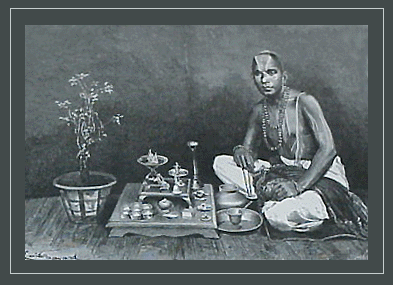
Vaisnava Brahman Preparing for Puja
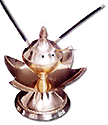
|
AGARBATTI STAND
Incense (agarbatti) comes in many forms, but stick incense is one of the easiest to use. The agarbatti stand may have holes to hold the sticks, and/or a vessel to hold cones or other forms of agarbatti. While it is preferable to use incense containing no synthetic substances, it isn't required. To make your own agarbatti, combine ingredients like the following together, forming small balls by mixing dry-roasted rice or barley flour as a base, then binding the ingredients to the base with ghee. Dip the balls in mustard oil before offering them on a burning coal or piece of dried burning cowdung.
Incense Ingredients: sandlewood, frankincense, camphor, jaggery, honey, cowdung, fenugreek, clove, cardamom, coriander, cumin, ginger, and cinnamon.
|
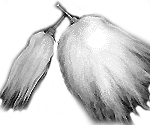
|
CHAMAR
Only yak tail Chamar fans should be used to offer arati worship. These generally come with a silver or other ornamental handle. They are best hung beside the altar on a peg, to keep the hairs straight and fine.
|

|
GHANTA
The sound of the gantha (bell) is dear to the Lord, and is sounded as offerings are made If no other form of kirtana is possible, the sound of the bell alone is sufficient. The ghanta should have a handle, and should be placed on a plate (the bell's asana) when not in use.
|
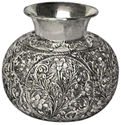
|
KALASH
Water for bathing or other arati uses may be kept in a kalash or similar water pot like a lota. In the Varaha Purana, the Lord states "I am more pleased by containers made of copper than by those made of gold, silver, or bell-metal." The kalash should be kept covered unless it is being used for water or other items after they've been offered (visarjaniya-patra).
|
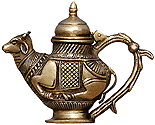
|
KAMANDALU
The kamandalu is another type of waterpot in the shape of Sri Cow. Kamandalus often come in copper, and are usually equipped with a lid.
|
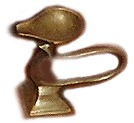
|
KAPUR
The kapur, also called eka-dipa, is a single-wick lamp for burning Camphor.
|
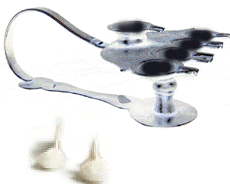
|
PAANCH-DIPA
Ghee lamps, called dipa, came in many varieties. Generally, they have an odd number of wicks. Full arati should be done using a 5-wick lamps, or a flat metal plate containing five ghee wicks. Make your own ghee wicks by rolling them from fresh, clean cotton so the bottom has a rounded base and the top tapers to a twisted point. Wicks that are soaked in the proper amount of ghee will burn perfectly. Only use ghee that has not been cooked in. You can roll dozens at a time and store them in a sealed plastic bag.
|
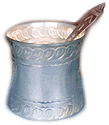
|
PANCHA-PATRA
The pancha-patra is a small cup with spoon that holds water used to purify the hands and paraphernalia during arati, Tulai Puja, etc.
|
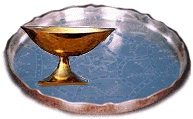
|
PATRANI
Patrani are vessels of various sizes and shapes that are used to hold flowers, Tulasi leaves and other items to be offered (or after they've been offered).
|
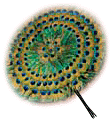
|
PEACOCK FAN
The peacock fan is only offered during aroti when the weather is warm. Like the Chamar, peacock fans should be hung from a peg in the wall, so they'll stay clean and keep their shape.
|

|
SHANKH, BATHING
The bathing shankh should sit on a pedestal (asana). Bathing shankhs may be of various sizes. Smaller ones may be used for offering water during arati, while larger bathing conches are used for abhisheka (bathing) ceremonies.
|
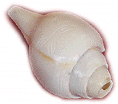
|
SHANKH, BLOWING
The best blowing conches are the Turbinella Shanks. The tip is sliced off and the rough edges polished, or set with a brass mouthpiece, for best use. The blowing conch may also be kept on a stand.
|

|
THALI
The puja-thali is a tray used to hold various arati paraphernalia. Using a thali with handles makes it easy to pick-up and carry when full of items. After use, items should be cleaned and polished, and may be kept in the thali with a cloth covering.
|

Atishaya Bazaar - Paraphernalia Catalog



|